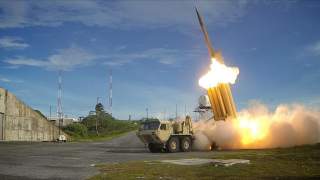Why THAAD in South Korea is a Red Line for China
Beijing is subtly trying to expand its sphere of influence.
In 2016, the South Korean government agreed to the 2017 installation of a U.S. missile defense system, Terminal High Altitude Area Defense. The objective arguments for South Korean missile defense are pretty irrefutable at this point. North Korea’s missile program is well known. Pyongyang conducted dozens of tests just last year, and even talks up intercontinental ballistic missiles and submarine-launched ballistic missiles. Its nuclear-weapons capabilities, after five tests in ten years, are well established also. And the regime’s harsh, extreme rhetoric about South Korea—turning Seoul into a “sea of fire”—is notorious. If any state in the world needs missile defense, it is South Korea.
The Chinese know all this. The Chinese also know that THAAD is not particularly effective against Chinese strategic forces. The South Korean THAAD radar will be configured around North Korea, not China, and cannot simply be “turned left”; the technology and software package is more complicated than that. The United States already has remote sensing for Chinese strategic launches in any case, so THAAD’s X-band radar adds nothing new. THAAD is also intended for use against a few incoming missiles (in their “terminal” phase, per the name of the system), not hundreds of missiles in the lift-off or boost stage, as would be the case were the Chinese to launch against the United States. American and South Korean officials have explained this to the Chinese repeatedly, and the media discussion of this has been quite extensive. It is hard to imagine that the Chinese are still unclear about the technical issues around THAAD.
Politically, South Korea has tried for years to work with China on the underlying issue—North Korea’s missilization—to no avail. South Korean president Park Geun-hye launched a three-year charm offensive to flatter the Chinese into a tougher line on North Korea. South Korea has consistently reached out to China to work on North Korea sanctions at the United Nations. Seoul has said THAAD is only a stop-gap measure until its own Korean Air and Missile Defense is completed. It is very obvious that South Korea wants some kind of deal with China on North Korea. The THAAD decision came only after years of prevarication, during which Seoul would likely have made major concessions for serious Chinese action on the North.
Yet the Chinese will not budge on THAAD, nor will they seriously enforce the sanctions. They warned South Korea for years not to accept THAAD and, in the last year, have threatened various punishments. Stephen Haggard conveniently brings together the many, often quite petty, ways in which the Chinese have struck back. Beijing is essentially demanding that South Korea remain defenseless—“roofless”—in the face of a spiraling nuclear missile threat on its doorstep. That is an astonishing ultimatum: to effectively surrender South Korean national security over an existential threat to demands of a foreign power. That China would make such a demand regarding an issue where the developments all broadly support the South Korean position—the North Korean missile threat is blatantly obvious, as is the South Korea’s thin defense—shows all the more chutzpah on Beijing’s part. The Chinese “argument” against THAAD is so preposterous that it is hard to read its demands against Seoul as anything but bullying power politics.
The question, then, is why. What is China’s objectively bizarre resistance to something so obvious telling us? For years, China vigorously promoted the idea that its rise was different from that of previous great powers. Its “peaceful rise” would open the possibility of a “new type of major power relationship” to promote a “harmonious world.” All would benefit from China’s growth, as the “One Belt, One Road” initiative tied Asia together. The Asian Infrastructure Investment Bank would help developing states. Even Chinese cultural production got in on the act. But in its maritime periphery, specifically, the South and East China Seas, China is acting, however quietly and obliquely, like a fairly typical aggrieved rising power. Its actions on Senkaku, the Paracels, Scarborough Shoal, North Korea and now THAAD all suggest that it expects regional states to bend to its demands conveniently packaged as uncontestable and expanding “core interests.”
This looks an awful lot like a sphere of influence by stealth. China has learned the cost of unnecessary belligerence. It is avoiding the forthright aggressiveness of Imperial Germany or the Soviet Union, which both provoked large counter-coalitions to their rise. Instead, it pursues a salami-slicing strategy of pushing here and there to see what happens. This escalating coercive diplomacy worked reasonably well with the Philippines, where President Rodrigo Duterte last year gave up and bandwagoned with China to appease it. And in South Korea, this year’s leftist presidential candidates are hinting that they will roll back the THAAD deployment. Seoul conservatives will read this as “kowtowing” to Beijing, but economic anxiety is rising, given South Korea’s asymmetric economic interdependence with China.
The next questions, then, are these: Will China try this bullying, using asymmetric economics and oblique threats as a lever, again elsewhere (Vietnam would be my guess)? And will Japan and the United States, the only regional powers with a serious ability to push back, eventually hit some kind of threshold and respond?
Robert Kelly (@Robert_E_Kelly) is an associate professor of international relations in the Department of Political Science at Pusan National University. More of his writing may be found at his website.
Image: THAAD interceptor is launched during a successful intercept test. Wikimedia Commons/U.S. Army

